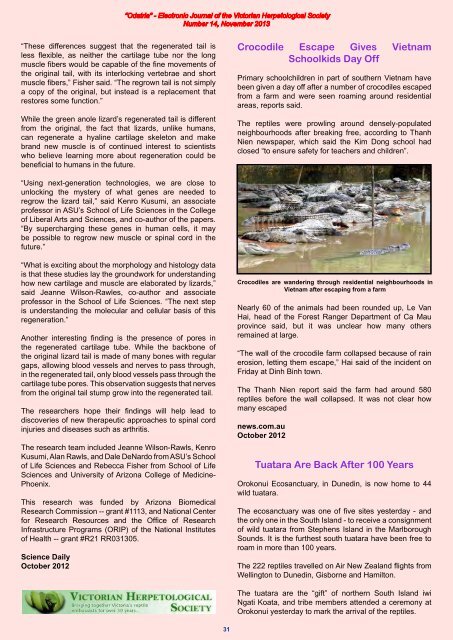Odatria_14_NOV13 - Victorian Herpetological Society
Odatria_14_NOV13 - Victorian Herpetological Society
Odatria_14_NOV13 - Victorian Herpetological Society
Create successful ePaper yourself
Turn your PDF publications into a flip-book with our unique Google optimized e-Paper software.
“These differences suggest that the regenerated tail isless flexible, as neither the cartilage tube nor the longmuscle fibers would be capable of the fine movements ofthe original tail, with its interlocking vertebrae and shortmuscle fibers,” Fisher said. “The regrown tail is not simplya copy of the original, but instead is a replacement thatrestores some function.”While the green anole lizard’s regenerated tail is differentfrom the original, the fact that lizards, unlike humans,can regenerate a hyaline cartilage skeleton and makebrand new muscle is of continued interest to scientistswho believe learning more about regeneration could bebeneficial to humans in the future.Crocodile Escape Gives VietnamSchoolkids Day OffPrimary schoolchildren in part of southern Vietnam havebeen given a day off after a number of crocodiles escapedfrom a farm and were seen roaming around residentialareas, reports said.The reptiles were prowling around densely-populatedneighbourhoods after breaking free, according to ThanhNien newspaper, which said the Kim Dong school hadclosed “to ensure safety for teachers and children”.“Using next-generation technologies, we are close tounlocking the mystery of what genes are needed toregrow the lizard tail,” said Kenro Kusumi, an associateprofessor in ASU’s School of Life Sciences in the Collegeof Liberal Arts and Sciences, and co-author of the papers.“By supercharging these genes in human cells, it maybe possible to regrow new muscle or spinal cord in thefuture.”“What is exciting about the morphology and histology datais that these studies lay the groundwork for understandinghow new cartilage and muscle are elaborated by lizards,”said Jeanne Wilson-Rawles, co-author and associateprofessor in the School of Life Sciences. “The next stepis understanding the molecular and cellular basis of thisregeneration.”Another interesting finding is the presence of pores inthe regenerated cartilage tube. While the backbone ofthe original lizard tail is made of many bones with regulargaps, allowing blood vessels and nerves to pass through,in the regenerated tail, only blood vessels pass through thecartilage tube pores. This observation suggests that nervesfrom the original tail stump grow into the regenerated tail.The researchers hope their findings will help lead todiscoveries of new therapeutic approaches to spinal cordinjuries and diseases such as arthritis.The research team included Jeanne Wilson-Rawls, KenroKusumi, Alan Rawls, and Dale DeNardo from ASU’s Schoolof Life Sciences and Rebecca Fisher from School of LifeSciences and University of Arizona College of Medicine-Phoenix.This research was funded by Arizona BiomedicalResearch Commission -- grant #1113, and National Centerfor Research Resources and the Office of ResearchInfrastructure Programs (ORIP) of the National Institutesof Health -- grant #R21 RR031305.Science DailyOctober 2012Crocodiles are wandering through residential neighbourhoods inVietnam after escaping from a farmNearly 60 of the animals had been rounded up, Le VanHai, head of the Forest Ranger Department of Ca Mauprovince said, but it was unclear how many othersremained at large.“The wall of the crocodile farm collapsed because of rainerosion, letting them escape,” Hai said of the incident onFriday at Dinh Binh town.The Thanh Nien report said the farm had around 580reptiles before the wall collapsed. It was not clear howmany escapednews.com.auOctober 2012Tuatara Are Back After 100 YearsOrokonui Ecosanctuary, in Dunedin, is now home to 44wild tuatara.The ecosanctuary was one of five sites yesterday - andthe only one in the South Island - to receive a consignmentof wild tuatara from Stephens Island in the MarlboroughSounds. It is the furthest south tuatara have been free toroam in more than 100 years.The 222 reptiles travelled on Air New Zealand flights fromWellington to Dunedin, Gisborne and Hamilton.The tuatara are the “gift” of northern South Island iwiNgati Koata, and tribe members attended a ceremony atOrokonui yesterday to mark the arrival of the reptiles.31


